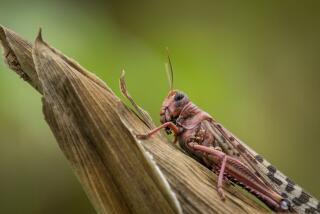BLACK LOCUST
- Share via
Although cultivated and named by Europeans, many species of the locust tree are native to the southeastern United States.
Many of these trees and shrubs now thrive in the western United States and Mexico.
Most frequently seen in the West is the black locust (Robinia pseudoacacia), a handsome tree so common that often it is overlooked. A fast-growing tree, it often reaches heights of 75 feet.
When mature, the black locust has a forked, angled trunk and an irregular, open crown of upright branches. The light gray or brownish bark is thick and deeply furrowed. The thorny twigs are dark brown with stout paired spines about one-fourth to one-half inch long.
Flowers are small and pea-shaped with five unequal white petals. They bloom in the spring and hang from drooping clusters four to eight inches long.
The pinnately compound leaves are divided like feathers into seven to 19 roundish leaflets--each one to two inches long. The leaflets are dark blue-green, hairy when young. They become droopy and fold at night.
The black locust bears fruit that is a narrow, oblong flat pod from two to four inches long. The pod matures and hangs on the tree all winter. Then, it splits open, spilling several flat, brown, beanlike seeds.
Black locust sprouts like a weed. Shown here are young locust trees in Angeles National Forest above Saugus.
Locust trees grow well in dry, rocky soils, woodlands and open areas. They often are used for erosion control.
The wood is so hard that Indians once made bows from it. Timber from the black locust was used as corner posts for the homes of American colonists, who discovered it at Jamestown in 1607.
Locust trees get their scientific name from John and Vespasian Robin, who first cultivated them in Europe.
More to Read
Sign up for Essential California
The most important California stories and recommendations in your inbox every morning.
You may occasionally receive promotional content from the Los Angeles Times.













